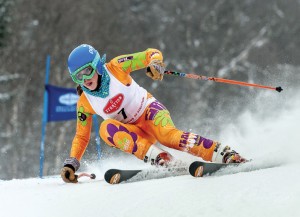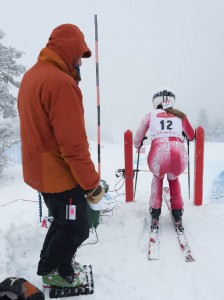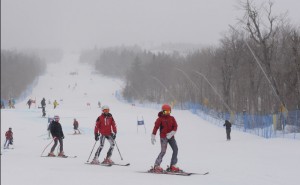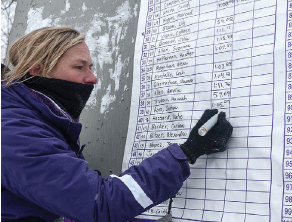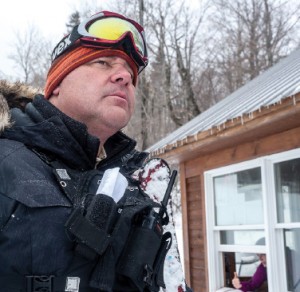By Andrew McKeever
Photography By Hubert Schriebl
It’s a lot of work for 60 seconds.
At least that’s what David Edry’s wife tells him when the subject of preparing the course for one of the races held each winter at Stratton Mountain comes up. David is the Alpine Program Director and head coach of the Stratton Mountain Winter Sports Program.
Each year, the program hosts several races for the Southern Vermont Council, which includes teams of young competitors from Stratton’s own ski racing program, Bromley Mountain, Mt. Snow, Mt. Snow Academy, Magic Mountain, the Stratton Mountain School and Willard Mountain, from over across the state line in New York. The range of skiing ability, which includes youngsters from under 10 years to under 16, is fairly wide, he says as he discusses what goes on behind the scenes.
The next day, the U-14 group, or under 14 year-olds, will be competing in a Super G. The difference between a Super G and a giant slalom is that the gates are further apart, with wider turns and the speeds the skiers obtain are higher. It’s sort of a cross between a downhill and a giant slalom — slower than a downhill but faster than a giant slalom.
“You’ll have academy kids—like some of the ones from SMS—who are among the best in the East,” Edry explains over a coffee in the base lodge. “And then you’ll have kids who maybe ski once a weekend, who come up and race because they love it. Different motivations, different levels, different goals.”
Fashioning a course that works for all those differing ability levels isn’t a cut and paste sort of task. There’s the mental challenge, and then there’s just a lot of plain hard work, where if you do everything right, the mark of success is one that nobody notices.
For Edry, one of the biggest issues— after the unpredictability of the weather—is assembling a group of volunteers to help build the course. Placing the gates on a trail, and the fencing along the sides of the course to catch an out-of-control skier, is a physically demanding task. The fencing goes up the day before the race. A team of about 15 people will gather 140 rolls of the blue linked plastic fencing, drill holes in the snow for the posts, and link them all together, up both sides of the trail. It’s a massive operation. The gates go in the morning of the race.
“To hold a race, I need about 20 volunteers to help me,” Edry continues. “I have a race administrator, Robbin Gibson, and she’s in charge of my timing, but then she needs to bring in three more people to help her with that. On the hill, we have jury members, and people in charge of back-up timing. We have 8 to 10 gatekeepers. We have start organizers, finish referees… To run a race, you need a lot of bodies.”
Then there’s the weather. This race has already been shifted ahead 24 hours from its original Sunday date to Saturday because of the weather forecast. When the weather conditions are less than ideal, it becomes a judgment call, he explains.
A jury of three people—one a socalled “technical delegate,” who is a full time race official or a coach from one of the participating teams, a “referee” and the “chief of the race” who in this case is Edry himself. The three will huddle together and make a decision about whether it’s a go or not.
“It’s all about safety,” Edry says. “Sometimes we’ll cancel a race after everyone’s here. It happens.”
This course today, which will be set up along a section of Stratton Mountain’s North American trail, will also feature two jumps. One of them needs to be trimmed down slightly to make it safer. It’s the first time a Super G at Stratton will include a jump, and Edry is keen to see how the young skiers handle it.
7 a.m., the morning of the race. It’s overcast, with temperatures hovering around 10 degrees Fahrenheit. Edry, Robbin Gibson (“my behindthe- scenes person who takes care of a lot of super-important stuff”, as Edry describes her) meet up at the ski school hut with about 10 volunteers who will help run the race. Other volunteers are already up on the mountain, getting the gates ready to be installed. They check their radios. They briefly discuss plans for the day. At 7:15, we ski over to the American Express six pack lift for the first leg of the journey up the mountain. We hop over to the Ursa lift, which we take to the summit. Then it’s down to the North American where the racecourse is being put together.
One group labors to install the starting gate and the timing apparatus, linked electronically to the finish line, where Gibson and her team are setting up. Edry and another group grab some large drills to bore holes in the snow for the gates. Others lug snow rakes and the gates and start setting the course by placing the gates in the drilled holes. Since their hands are filled with equipment of one sort or another, they ski without using ski poles.
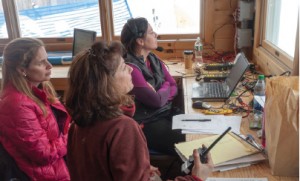
the timing hut at the finish
They work quickly. The course has to be set up by 9:15 a.m. for an inspection and the mandatory training runs. Edry uses a digital range-finding tool to measure the distance between what will eventually be a course of 38 gates that racers will traverse from start to finish. The total distance of the course will cover a vertical drop of about 290 meters. Most of the skiers will finish it in just under a minute.
All the while, the radios crackle with chatter of one sort or another. Someone, possibly a parent of one of the racers, has wandered onto the course and needs to be escorted off. Issues pop up with the timing operation. Someone has to serve as the bearer of a yellow caution flag in case of an accident— do we have one ready?
Then it’s time to spray paint some blue dye along parts of the course, to help outline the sections where vertical declines are most pronounced.
Sometime between his arrival on the course that morning and the start of the training runs which will soak up the rest of the morning (the actual race itself won’t start until noon or so) Edry wants to find the time to go over the course and race strategy with his own group of racers from the Stratton Winter Sports Club. They slip-slide down the course, which has been carefully groomed and manicured and will be again. No snowplowing is allowed now—it disturbs the snow and the grooming too much.
“So guys, listen up,” he says, motioning to his group of athletes. “Where you see that group of four people up there, on the right—that’s a key turn. Why is that a key turn?” he asks.
Silence.
“Because there’s a flat section after that and you have to let your skis run,” meaning that they have to get pointed back downwards to maintain speed. “If you’re too straight there, you’re on the wrong line. That gate is critical; a good turn there can make this section fast,” he says, pointing to the area around where they are standing. “If you want to go faster, go faster. Let’s have fun today.”
Before the race itself starts, every racer who’s competing at the U-14 level has to navigate the course once before the actual timed race. The focus here is familiarizing them with the quirks of the course. It’s also a chance for the race directors to determine if the course is set up correctly and if any kinks need straightening out before the main event.
Before the training runs start, however, the course will be tested by a group of adult skiers, known as forerunners. They are usually coaches or some from among the group of volunteers helping out.
As the saying goes, safety first.
While today’s three forerunners are preparing to test the course, the two-way radios buzz incessantly. Radio: Blue-ing is complete. Edry: Awesome. Do we have someone to man the yellow flag?
Radio: OK, I’ll ski down.
Edry: Do we have communication with the start?
Robbin: (on radio): Yes we do, we need one more minute.
Edry: CLEAR THE COURSE!
The forerunners start. One of them nearly loses it on one turn. Another posts a pretty decent time. All is noted with a mixture of seriousness and good-natured ribbing.
Finally, after what is already beginning to seem like a long day, the training runs begin. There will be 72 boys and 57 girls competing, and each of them will ski the course once before they do it “for real.” The first skier through the course zips down it and posts what seems like a pretty good time. The second skier crashes. But since it’s a training run, she is allowed to get up and finish the course.
One by one, the racers arc through the course on their training runs. The pace is brisk, if unhurried, but with more than 120 skiers to run the course, and a need to refurbish the course for the actual race, there isn’t a lot of time to spare.
Every 40 seconds or so, skiers whiz past on their training runs. Things seem to be running smoothly. Edry stops to concentrate on one of the skiers from his own team. He notices a slick place at one spot, and decides to make a course adjustment.
Meanwhile, down at the timing shed by the finish line, six people are intently entering timing results and following the action from inside a small wooden chalet-like building on the side of the trail.
Here is where Robbin Gibson, Edry’s “behindthe scenes” special operative, holds forth. A pair of laptop computers are used to enter the results and keep track of things. The radio ticks off the numbers of the racers who are starting up top. 83 starting, 84 in the gate. One skier is held for faulty equipment. Another one lacks a bib.
It’s now officially cold outside, and over the radio Edry says he’s getting concerned about the weather. It looks like the race won’t start until 12:45, instead of 12:30, as planned.
In ski racing, timing is everything when it comes to determining winners and also-rans. Timing has to be accurate, reliable and verifiable. The trick lies in good preparation and staying focused on what’s going on, Gibson tells me during a break in the action.
The timers tell the start gate when they’re ready; the skier will then be released from the start gate. There’s a primary system and two back up systems— no margin for error.
Two electric lines run up the side of the trail. At the start, a skier pushes out of the gate which starts the timing on that particular racer. As skiers finish, they break an electronic beam at the finish line which feeds the time into the computers.
Most of the time, the system works fine, but you have to be prepared for the unexpected—when the snow from a snowmaking gun produces drag on the electric wires that connect the start with the timers. Sometimes in a heavy snowfall, a single snowflake can interrupt the finish beam, and give a false reading, Gibson added. It happens.
“The computer does it all but we have to oversee everything,” she says. “It’s getting starting impulses and finish impulses, but we have to tell it whose time it’s looking at and put that into the timing program properly.”
The practice runs now over, I head back up to the starting area where the various teams competing today are getting last-minute instructions and advice from their coaches. Some of the competitors are lying together in a bundle in sort of a meditative trance; there’s a surprising air of calmness that you wouldn’t expect from a group of 12 and 13 year-olds. That does change, however.
I walk over and strike up a conversation with Kristin Pastore, a member of the team from Mt. Snow. She’s from Ridgefield, Connecticut, and this is her first year in racing, she tells me. This will also be her only Super G event of the season, she adds.
“It’s fun,” she says, “but kind of scary too”.
One of her teammates, Alex Welter, from Babylon, New York, skis over and joins the chat.
She’s been racing since she was about 10, or about three years ago she says.
“The conditions are good, and the snow is soft, easier to edge,” she says. “It’s kind of nerve-wracking; I enjoy it, but you get pretty nervous.”
What about those jumps? Any worries?
“If you get air, it can throw you off a little, but I’m not going to worry too much about that,” she says.
The skies are solidly overcast, but the course is clear, and you can see all the way down to the finish line. And now it’s show time. All the work—the fencing, the timing, setting up the course—has all been for this moment.
One racer stands in the gate ready to push the metal wand aside when given the signal by the start. Another skier is lined up right behind, ready to start about 40 seconds later. They lean forward, over the thin metal wand that brushes up against their knees, poles planted in front of it. They get a 10 second warning and can start anytime after that point. Some take a last moment to reflect. Others don’t wait. Another will follow in turn as the chute fills up with skiers. Now the noise level has stepped up a notch.
“C’mon Hannah—go get it girl!” someone shouts as one racer—presumably Hannah—busts out of the starting gate.
The excitement level may be a controlled exuberance at the starting area, but down below, at the other end, it’ s a different picture all together where the parents wait for their kids to navigate the course. It’s easier being in the race than having to watch it, confides one parent as she follows the dot-like skiers down the course. The wind has picked up and the temperatures seem to nudge down even more.
Alex Lynch, from Bondville, has a son, Ian, in the race who’s is attending Stratton Mountain School and has been racing since he was six years old.
“It’s very nerve-wracking,” he says. “I think it’s harder on the parents.”
Guy Fava, another parent, from Mahwah, New Jersey, agrees. He has had children in the Stratton Mountain Race program since they were very young.
“The Super G is a little faster and a little more dangerous,” he says. “But they’re kids, so they like to go fast.”
In the end, the day would belong to the skiers from the Stratton Mountain School, who grabbed the top three finishing times in the girls division, with Hana Kusumi finishing first with a time of 57.13 seconds. Barely half a second separated her from the next two finishers, Mikayla Lathrop and Hannah Trudeau, who finished one-one hundredth of a second apart at 57.68 and 57.69 seconds respectively.
Over in the boys division, it was almost the same story. Will Trudeau of SMS finished first, with a time of 54.94 seconds. His teammate, John Alpert was next, at 55.90. Liam McNamara, from the Stratton Training Center (Stratton’s team) was third, at 56.95.
As David Edry might have said, it may be a lot of work for (less than) 60 seconds, but it’s definitely worth it. ◊
Andrew McKeever is a freelance writer from Sunderland.
